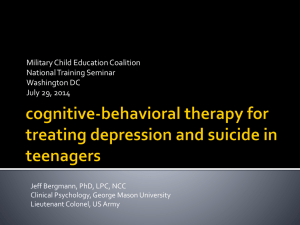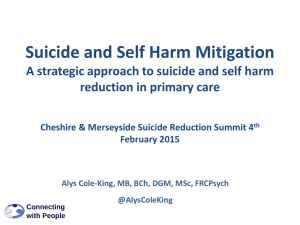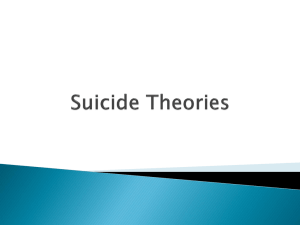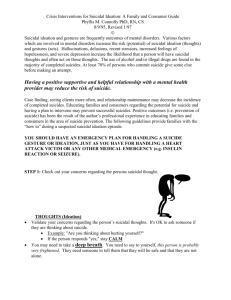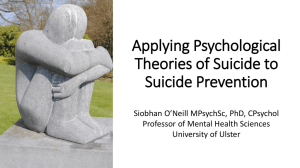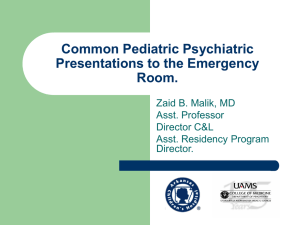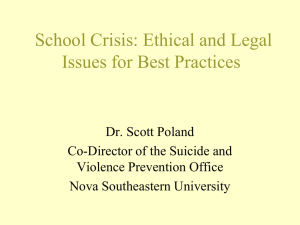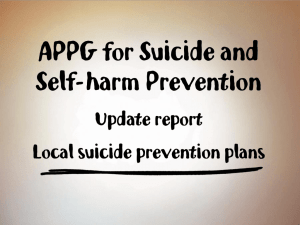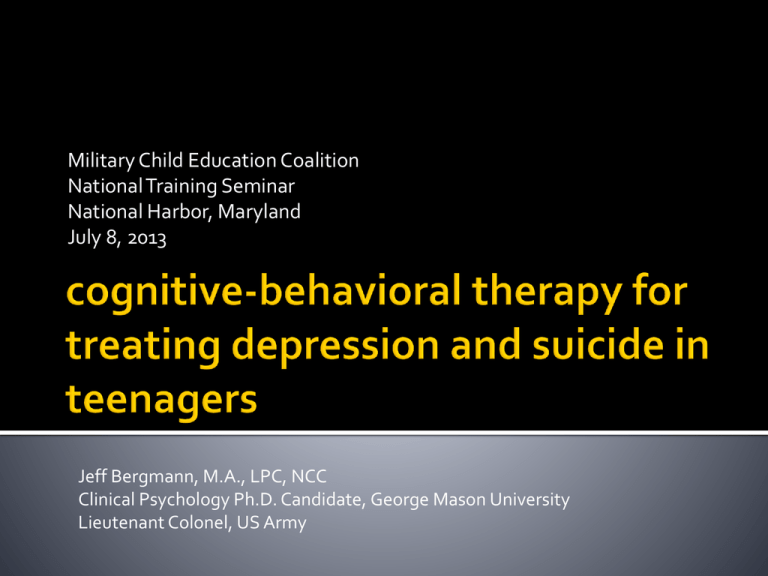
Military Child Education Coalition
National Training Seminar
National Harbor, Maryland
July 8, 2013
Jeff Bergmann, M.A., LPC, NCC
Clinical Psychology Ph.D. Candidate, George Mason University
Lieutenant Colonel, US Army
introduction (5 minutes)
cognitive-behavioral
theory (5 minutes)
conceptualization of
how depression
develops (5 minutes)
maintenance of
depressive symptoms (5
minutes)
treatment plan
development (10
minutes)
conceptualization of how
suicidal ideation
develops (10 minutes)
maintenance of suicidal
symptoms (10 minutes)
treatment plan
development (10
minutes)
teen case studies
practical exercise (20
minutes)
questions (10 minutes)
Information for this workshop is taken from the CBT Teen Depression Manual authored and utilized by Dr.
Christy Espisito-Symthers in training psychologists at George Mason University.
Information presented in this workshop is not intended for use by unlicensed mental health professionals,
does not reflect endorsement by George Mason University, the US Army or the Department of Defense.
The material presented reflects the views of the presenter and is intended for self-awareness educational
and informational purposes only.
This workshop presents cognitive-behavioral theory conceptualization of the
development and maintenance of teenage depression and suicidal ideation.
Information is presented to describe the connection of thoughts, behaviors, and
feelings to the development and maintenance of depression and suicidal ideation. The
information includes how a cognitive-behavioral therapy treatment plan is developed
and implemented. Practical application include processing two case studies of
military-connected teenagers, one dealing with depression and the other depression
and suicidal ideation, for the purposes of illustrating the cognitive-behavioral
conceptualization and developing a treatment plan. The following skills would be
introduced and illustrated: deep breathing, progressive muscle relaxation, problems
solving, thought challenging, cognitive restructuring, behavioral activation, and
suicidal ideation safety plans.
deep breathing
progressive muscle relaxation
problem solving
thought challenging
cognitive restructuring
behavioral activation
suicidal ideation safety planning
“There must be something wrong
with me. I am such a loser! I can’t stand
my life. I feel so angry and sad”
↓
Isolate in room
↓
Feel more sad and angry
Feel better
↑
Call a friend and make
plans to go see a movie
↑
“It’s his/her loss. I can
do better. He/she was not
really my type anyway.”
1. Is it true?
Am I making a thinking mistake?
What evidence do I have that it is true/false?
What would my friend say if he/she heard this belief?
2. Is this belief helpful?
Does this belief help get me what I want?
Does this belief help me feel the way I want?
Does this belief help me avoid conflicts?
15 year-old April just relocated to Texas
April hates hot weather
April thinks Texas is obnoxious
April left her 17 year-old boyfriend back in NY
and is worried the relationship won’t last
April is not adjusting well in her new school
and her mom has noticed an increased
pattern of withdrawal
April says no one in Texas likes her
Depression Development & Maintenance
CBT Triangle
Thinking-Behaving-Feeling Spirals
Treatment Plan
Psychoeducation (Information)
Thought Challenging & Cognitive Restructuring
Behavioral Activation
1st Step: Activating Event
__________________________________________________________
2nd Step: Beliefs (skip 2nd step)
1_________________________________________________________
2_________________________________________________________
3_________________________________________________________
4_________________________________________________________
3rd Step: Consequences or Feelings (go back to 2nd step)
1___________________________ 2___________________________
4th Step: Disputes
1_________________________________________________________
2_________________________________________________________
3_________________________________________________________
4_________________________________________________________
5th Step: Effect or Change
1. I feel better
2. I can make better decisions
HELP WITH DISPUTING BELIEFS
You view a situation or person as all good
or all bad, without noticing any points in between.
You predict the future negatively without
considering other more likely outcomes.
You focus on the negatives and fail to
recognize your positive experiences and qualities.
You think something must be true because
you “feel” it so strongly, ignoring evidence to the contrary.
You assume that you know what
others are thinking without asking.
You assume that you can control how
others behave in situations where you really don’t have any control.
You believe that you (or others) should
be perfect in the things that you (or others) say or do.
Name: ________________________
Date: _________________________
Select problem:_____________________________________________________
Options
Likely Outcome (+, -, +/-)
1. ________________________________
2._________________________________
3. _________________________________
4. _________________________________
5. _________________________________
6. _________________________________
7. _________________________________
8. _________________________________
Circle the
Very Best One
_______________________________
Evaluate: How well did it work?
1
not
well
2
3
4
5
very
well
DEGREE OF SUICIDE RISK
1. How frequent have your suicidal thoughts been (everyday, few days a
week, etc.)? How long do they last when you do have them (most of the
day, few hours, few minutes)?
2. Have you told anyone about your suicidal thoughts?
3. Do you have a suicide plan? How long have you been thinking about
this plan? Have you made preparations for this plan? Have you acted on
this plan in any way (e.g., held pills in hand)? Do you intend to act on this
plan?
4. Have you made any final preparations for a suicide attempt (e.g.,
suicide note, given away belongings)?
5. One a scale of 1 (not at all likely) to 10 (highly likely), what is the
likelihood that you will make a suicide attempt?
PREFERRED METHOD FOR SUICIDE
1. If you were to make an attempt, how would you do it?
2. Do you have access to this method at your home or anyone else’s?
3. Do you have access to guns at your home or anyone else’s? Do you
have access to ammunition?
4. Do you have access to pills at your home or anyone else’s? If so, how
many, what type, and how are they stored (e.g., locked up)?
INTOXICATION
1. Have you used any alcohol or drugs recently? Was the use of drugs or
alcohol associated with your suicidal thoughts?
2. If yes, do you plan to continue to use drugs or alcohol? Do you have
access to drugs or alcohol?
SUICIDE PRECIPITANT
1. What triggered your suicidal thoughts?
2. Does that problem still exist?
3. Can you avoid this problem in the future?
Do you intend to avoid this problem?
1. Do you actually want to die? Or, is it that you don’t really want
to die but do want to escape an intolerable situation?
2. Do you think that things will get better with time or is this
situation hopeless?
3. What reasons do you have for living? Let’s list any reasons that
you have on this Reasons For Living List.
[Note: Examples might include future plans mentioned in previous
sessions, leaving parents/siblings/family member/pet he/she cares
about, the way people might feel if he/she committed suicide,
things he/she will never get to do, or anything important to the
teen.]
_____________________________________________________________
_____________________________________________________________
_____________________________________________________________
_____________________________________________________________
_____________________________________________________________
1. Can you 100% promise that you will not attempt suicide between now and the next
outpatient appointment? (Note - this is asked for assessment purposes not
intervention)
2. Can you promise that you will inform an adult should you feel in danger of making a
suicide attempt? Who will you tell? (Inquire about people in and outside the home).
What are their phone numbers? Let’s write them down on this Safety Plan. Be sure to
keep them by your phone at home.
3. If there is not an adult available when/if you were to feel in danger of attempting
suicide, will you promise to phone me (if during hours when I am available), call the
suicide hotline, go to/have someone take you to the nearest emergency room, or call
911 for help? Can you think of anything that could get in the way of you using this plan?
4. Will you make every effort to avoid activities/situations which you believe may
increase the chance of thinking about or attempting suicide?
5. If you are unable to avoid these activities/situations or others that leave you feeling
very upset, what can you do to help calm yourself down? These can be things that you
can do or tell yourself. Let’s write them down on this Safety Plan.
[NOTE: If teen was able to list any reasons for living be sure to have him/her include
“read reasons for living list” as a coping technique].
SAFETY PLAN
As part of my therapy, I ___________________________, agree to the following:
1. One of my goals is to work on my problems to help myself feel better.
2. While working on my problems, I will keep myself safe and not end my life.
3. If at any time I should feel unable to keep myself safe, I will immediately tell at
least one of the following adults and call my therapist (during office hours).
________________________________ at (_____)__________________
________________________________ at (_____)__________________
________________________________ at (_____)__________________
Therapist:________________________ at (_____)__________________
4. If I am unable to reach an adult immediately, I will call a suicide hotline (listed
below), call 911 for help, or go to a local emergency room.
1-800-273-TALK (8255) National Suicide Prevention Lifeline
1-800-SUICIDE (784-2433) HOPELINE
5. I will also use the following coping techniques to help calm myself as needed.
_____________________________
_____________________________
_____________________________
_____________________________
_____________________________
_____________________________
_____________________________
_____________________________
_______________________ _______
Signature
Date
_______________________ _______
Therapist’s Signature
Date
1st
____________
2nd
____________
rd
3
____________
4th
____________
1st Step: Activating Event
__________________________________________________________
2nd Step: Beliefs (skip 2nd step)
1_________________________________________________________
2_________________________________________________________
3_________________________________________________________
4_________________________________________________________
3rd Step: Consequences or Feelings (go back to 2nd step)
1___________________________ 2___________________________
4th Step: Disputes
1_________________________________________________________
2_________________________________________________________
3_________________________________________________________
4_________________________________________________________
5th Step: Effect or Change
1. I feel better
2. I can make better decisions
HELP WITH DISPUTING BELIEFS
You view a situation or person as all good
or all bad, without noticing any points in between.
You predict the future negatively without
considering other more likely outcomes.
You focus on the negatives and fail to
recognize your positive experiences and qualities.
You think something must be true because
you “feel” it so strongly, ignoring evidence to the contrary.
You assume that you know what
others are thinking without asking.
You assume that you can control how
others behave in situations where you really don’t have any control.
You believe that you (or others) should
be perfect in the things that you (or others) say or do.
Name: ________________________
Date: _________________________
Select problem:_____________________________________________________
Options
Likely Outcome (+, -, +/-)
1. ________________________________
2._________________________________
3. _________________________________
4. _________________________________
5. _________________________________
6. _________________________________
7. _________________________________
8. _________________________________
Circle the
Very Best One
_______________________________
Evaluate: How well did it work?
1
not
well
2
3
4
5
very
well
GUIDED IMAGERY SCRIPT
I would like you to sit back, relax, and practice your deep breathing. Breathe in through your nose………and out through your
mouth…………..in through your nose……. and out through your mouth…..just keep deep breathing for a few
moments…….……Keep your eyes closed until your journey is over………
Good. Now we are going to take an imaginary trip. Imagine that we leave this room, go down the stairs, and through the hall
to the door. Outside of the door waiting for you is a hot air balloon. The balloon has big beautiful bright stripes of color on it,
red……blue….. green……
…orange….. and yellow. Across the middle is your name written in big black letters. This is your very own balloon for the day. You
climb inside the big sturdy brown wicker basket underneath the balloon. Once you are settled, it slowly takes off into the air. You have
control over how high off the ground the balloon will go. The wicker basket that you stand in has high sides so that you don’t have to
worry about falling out. You feel very very safe. As the balloon takes off, you feel excited about the trip you are about to take. The
balloon begins to float slowly through the air. You float over trees bustling with green leaves waiving in the wind. You fly over
tranquil blue lakes that sparkle with the sunshine. As you look down you also see streets and highways with cars that look like they are
the size of march box cars whizzing by. You can see the roofs of long shopping malls and tall office buildings. As you float out of the
city you leave the busy streets behind and start to see only the countryside. You fly over trees of many different shades of green,
orange, red, and yellow. Then wide rambling green fields with big bright flowers blowing in the wind which seem to go on for miles
and miles. All the while you hear the soft breeze blow by your ears and nothing else. Now your balloon is headed toward the coast.
As it approaches, you begin to see the deep blue ocean and a sandy beach in the distance. You can hear the soft roar of the waves as
they reach the shore. You notice that the air is getting warmer and it makes you feel more and more relaxed. The closer you get to the
beach the better you can see the clear, white sand. The balloon begins to slowly descend as you reach your destination. The balloon
lands softly on the white sand. You take off your shoes, grab the big soft royal blue beach towel lying in the balloon basket, and step
out of the basket onto the sand. The white sand feels soft and warm under your feet. You scrunch your toes in the sand for a moment
and feel its smooth soft texture. You can taste the salt in the air and smell the refreshing clean scent of the ocean. You begin to
walking down the beach looking for a good spot to lay down in the sun. After you find your spot, you lay your oversized blue beach
towel on the warm sand and then lie down. You feel very very relaxed and happy to be there. There is not a cloud in the sky and the
sun is warm. You can feel the sun on your body. The sun makes you feel very very relaxed. You hear the rhythmic waves splash
against the shore. The waves go in and out, in and out. They seem to match your breathing. You breathe in and out, in and out. With
every breath you take in, you feel more and more relaxed. With every breath you let out, you let go of your tension. You hear the
seagulls calling above you. It is just you and the seagulls on this beach. It is ever so peaceful. You pick up a handful of sand and let
the sand trickle through your fingers. You feel very relaxed. Lay here for a while and enjoy how relaxed you feel. Remember how
this moment feels. LONG PAUSE.
Deep Breathing
Progressive Muscle Relaxation
Request for research participants!
Online survey (45 minutes) for veterans, National Guard, reserves & active duty
related to deployments, psychological well-being, sleep problems, character
strengths and academic transitions.
Questions/Discussion

